Table of contents
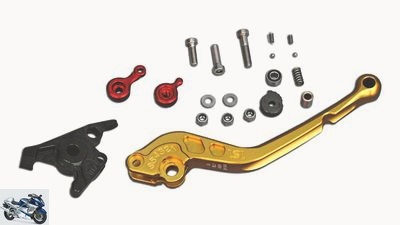
Schermer
counselor
workshop
Brake and clutch levers care and replacement
Workshop: hand lever maintenance and new acquisition
Brake and clutch levers care and replacement
Hand levers also need a little affection and care, i.e. cleaning and fresh grease. Sometimes they break off and you have to screw on new ones. Or you want nicer and more practical levers. Here is what to do.
Franz Josef Schermer
09/27/2012
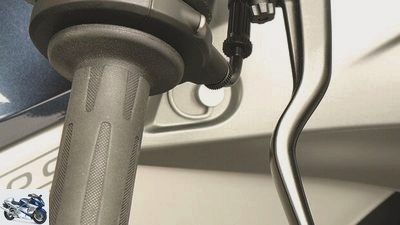
Schermer
After assembly: Adjust the lever distance as required
The two hand levers on the handlebars for the front brake and clutch must be easy to move; because only with this requirement is it guaranteed that the brake and clutch can be precisely dosed. It makes no difference whether the brake and clutch are operated hydraulically or via a cable, because they always have a lever joint.
It cannot be emphasized enough: brakes and clutches are existentially important for general road safety, because what happens when you cannot fine-tune the front brake due to a stiff brake lever hurts just thinking about it: fall, crash, ouch, on the flap falls, the motorcycle slips into the guardrail or into the oncoming traffic, the driver hurts quite a bit. The Sunday drive is over, and it also costs money. And a lot.
On most motorcycles, the two hand levers are fully in the open; This is often the case, at least with naked bikes. Well, some have rubber covers over the joints, but even these (quite useful) accessories have become rare in recent years because they cost motorcycle manufacturers money. And everything that costs is rationalized away by unpractical bureaucrats and controllers who have no idea about motorcycling and the needs, worries and needs of a motorcycle that is driven through wind and weather.
Buy complete article
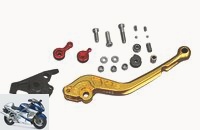
Workshop: hand lever maintenance and new acquisition
Brake and clutch levers care and replacement
2 pages) as PDF
€ 2.00
Buy now
“Feel” the stiff Bowden cable
If a lever begins to move “difficult” and the Bowden cable hooks now and then, depending on the position of the control lever, the cause is usually a stiff nipple that can no longer move properly in its seat in the lever. To determine this, operate the lever extremely slowly, feel with your fingers and also look carefully. You may see that the cable kinks when you pull the lever. Then act immediately, because the pull will soon tear at the kink.
Other reasons for a stiff lever are dirt in the lever joint or a dry, i.e. unlubricated joint. Both problems can be dealt with in one go: remove the lever, clean the joints and reassemble with a finger full of grease.
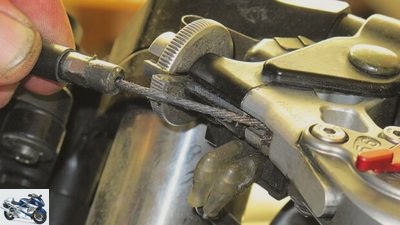
Schermer
Adjust the cable for maximum play, remove the cable casing from the seat.
Remove lever:
- Adjust the clutch or brake cable to maximum play by screwing the adjusting screw all the way into the lever mount.
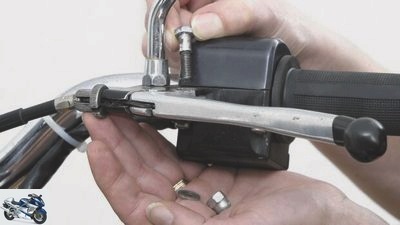
Schermer
Carefully loosen the screw and lock nut on the lever.
- Align the slot of the adjusting screw (and also the lock nut, if there is one) with the slot in the lever mount.
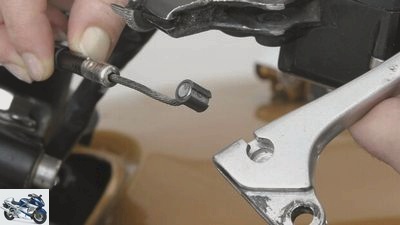
Schermer
Dismantle the lever to make it easier to unhook the train.
- With one hand, grab the cable casing just behind its seat in the adjusting screw, with the other hand tighten the lever a little, let go, at the same time pull the cable casing out of its seat, fumble the inner cable out of the slot and pull the nipple down from its seat in the lever.
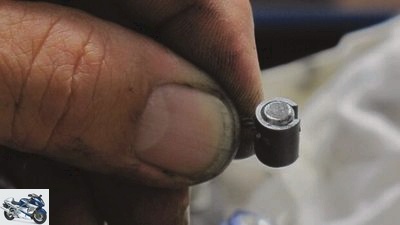
Schermer
Ensure that the plastic sleeve is correctly positioned on the nipple.
- Remove the hinge screw: Usually a lock nut is screwed on at the bottom, unscrew it first, then unscrew the hinge screw.
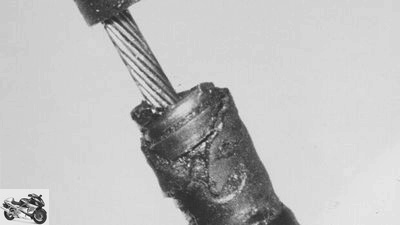
Schermer
Cable casing broken, the Bowden cable should be replaced here.
Important: When pulling the lever out of the lever holder, hold your hand underneath it, because sometimes thin wave washers are installed, which distance the lever in its U holder or prevent it from rattling. A small spring with a ball can also be used, which is used to actuate the clutch or brake switch. In many cases a small bushing is inserted in the joint hole of the lever, and if this is lost, the lever can unfortunately no longer be installed properly.
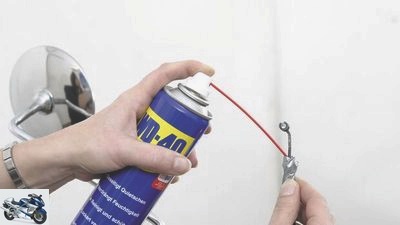
Schermer
Do not use chain spray for Bowden cable lubrication.
Also important: Take a close look at the Bowden cable before assembling – hold it vertically, grab the nipple and move it back and forth as far as possible. Does it run easily? Are all wires of the inner cable (wound from several individual wires) straight, i.e. neither kinked nor broken? Put a good shot of spray oil (for example WD-40) or resin-free sewing machine oil into the Bowden cable while moving the inner cable back and forth. With an old Bowden cable, dirty liquid runs out from the bottom – that’s nothing more than dirt. Then smear a little thin grease into the train.
Important again: DO NOT use chain spray or thick gear oil to lubricate the Bowden cable!
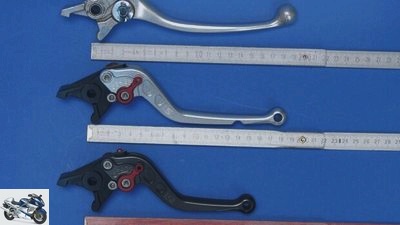
Schermer
Series levers are often too long and ergonomically not optimally shaped (above). Accessory levers convert hand forces better, racing levers are extremely short.
Mount short racing levers
Most of the standard hand levers are too long, because: where and in which finger do you have the most power? Certainly not in the little finger, but in the index and middle finger. And they attack the inside of the lever.
In recent years, short, forged hand levers have become very fashionable; The pioneer is the accessories brand LSL, known for first-class workmanship and great attention to detail quality. There are two versions, namely short and long. The short levers are very crisp, racers in particular like to mount them, because no end of the lever comes into contact with other machines during hand-to-hand combat (e.g. when braking, the brake lever touches the rear of the vehicle in front, which results in full front braking, maybe even one with somersault mortale).
Properly made retrofit levers have an ABE (General Operating Permit), which must be carried with you and shown to the inspecting officer when requested. Incidentally, this only applies to the brake lever, the clutch lever is not subject to ABE. In the case of a police check, it is usually sufficient to refer to the ABE number engraved on the lever, but if you have the ABE paper with you, it’s not a mistake. This is especially true abroad, because Austrian or Swiss officials are often overly precise at a traffic control and easily go overboard.
When assembling short racing levers, the same applies as already said in the text above; Cleaning and lubricating is always a good thing so that the levers move easily and are always at hand.
Related articles
-
counselor workshop Adjust shift and brake levers Adjust shift and brake levers Adjust shift and brake levers The levers have to be positioned correctly…
-
Change brake discs yourself – tips and tricks
Markus Jahn 9 pictures Ralf Schneider 1/9 There is a need for action here! The heat spots on the panes shown on the left can certainly no longer be…
-
Brembo at EICMA: GP4-rr brake caliper and radial clutch pump
Motorcycle fair in Milan EICMA 2021 Presented by Brembo accesories landing gear & Spring elements Brembo at EICMA: GP4-rr brake caliper and radial clutch…
-
Triumph patent: foot levers that can be adjusted without tools
Triumph Motorcycles 4th pictures Triumph Motorcycles 1/4 The footrest # 22 is still hinged on the brake lever # 20. For the tool-free adjustment system,…
-
Schermer counselor workshop Change brake fluid Change brake fluid Fill the brake system with new fluid Soft pressure point, spongy brake. It is high time…
-
jkuenstle.de counselor workshop Working on the drum brake Working on the drum brake Not only a disc brake needs care You are completely isolated from the…
-
How to change the clutch on your motorcycle
counselor workshop How to change the clutch on your motorcycle Workshop: clutch change, part 1 How to change the clutch on your motorcycle Engage first…
-
Guide to changing the brake pads on the motorcycle
Ralf Schneider counselor workshop Guide to changing the brake pads on the motorcycle Change the brake pads on the motorcycle Tips from professionals…
-
Advice: Remove and maintain shock absorbers and reversing levers
Cook counselor technology & future Advice: Remove / maintain shock absorbers and reversing levers Advice: Remove / maintain shock absorbers and reversing…
-
Guide: Basic set of care products and lubricants
Schermer counselor workshop Guide: Basic set of care products and lubricants Guide: Basic set of care products and lubricants Chemistry in the workshop…